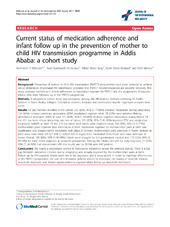| dc.contributor.author | Mirkuzie, Alemnesh Hailemariam | en_US |
| dc.contributor.author | Hinderaker, Sven Gudmund | en_US |
| dc.contributor.author | Sisay, Mitike Molla | en_US |
| dc.contributor.author | Moland, Karen Marie | en_US |
| dc.contributor.author | Mørkve, Odd | en_US |
| dc.date.accessioned | 2012-02-06T10:08:56Z | |
| dc.date.available | 2012-02-06T10:08:56Z | |
| dc.date.issued | 2011-10-21 | eng |
| dc.Published | Journal of the International AIDS Society 14: 50 | en |
| dc.identifier.issn | 1758-2652 | |
| dc.identifier.uri | https://hdl.handle.net/1956/5547 | |
| dc.description.abstract | Background: Prevention of mother to child HIV transmission (PMTCT) programmes have great potential to achieve virtual elimination of perinatal HIV transmission provided that PMTCT recommendations are properly followed. This study assessed mothers and infants adherence to medication regimen for PMTCT and the proportions of exposed infants who were followed up in the PMTCT programme. Methods: A prospective cohort study was conducted among 282 HIV-positive mothers attending 15 health facilities in Addis Ababa, Ethiopia. Descriptive statistics, bivariate and mulitivariate logistic regression analyses were done. Results: Of 282 mothers enrolled in the cohort, 232 (82%, 95% CI 77-86%) initiated medication during pregnancy, 154 (64%) initiated combined zidovudine (ZDV) prophylaxis regimen while 78 (33%) were initiated lifelong antiretroviral treatment (ART). In total, 171 (60%, 95% CI 55-66%) mothers ingested medication during labour. Of the 221 live born infants (including two sets of twins), 191 (87%, 95% CI 81-90%) ingested ZDV and single-dose nevirapine (sdNVP) at birth. Of the 219 live births (twin births were counted once), 148 (68%, 95% CI 61-73%) mother-infant pairs ingested their medication at birth. Medication ingested by mother-infant pairs at birth was significantly and independently associated with place of delivery. Mother-infant pairs attended in health facilities at birth were more likely (OR 6.7 95% CI 2.90-21.65) to ingest their medication than those who were attended at home. Overall, 189 (86%, 95% CI 80-90%) infants were brought for first pentavalent vaccine and 115 (52%, 95% CI 45-58%) for early infant diagnosis at six-weeks postpartum. Among the infants brought for early diagnosis, 71 (32%, 95% CI 26-39%) had documented HIV test results and six (8.4%) were HIV positive. Conclusions: We found a progressive decline in medication adherence across the perinatal period. There is a big gap between mediation initiated during pregnancy and actually ingested by the mother-infant pairs at birth. Follow up for HIV-exposed infants seem not to be organized and is inconsistent. In order to maximize effectiveness of the PMTCT programme, the rate of institutional delivery should be increased, the quality of obstetric services should be improved and missed opportunities to exposed infant follow up should be minimized. | en_US |
| dc.language.iso | eng | eng |
| dc.publisher | BioMed Central | eng |
| dc.relation.ispartof | <a href="http://hdl.handle.net/1956/5605" target="blank">Successes and challenges of the national programme for the prevention of mother-to-child HIV transmission (PMTCT) in Addis Ababa, Ethiopia. Implementation and impact</a> | eng |
| dc.rights | Attribution CC BY | eng |
| dc.rights.uri | http://creativecommons.org/licenses/by/2.0/ | eng |
| dc.title | Current status of medication adherence and infant follow up in the prevention of mother to child HIV transmission programme in Addis Ababa: a cohort study | en_US |
| dc.type | Peer reviewed | |
| dc.type | Journal article | |
| dc.description.version | publishedVersion | en_US |
| dc.rights.holder | Copyright 2011 Mirkuzie et al; licensee BioMed Central Ltd. | |
| dc.identifier.doi | https://doi.org/10.1186/1758-2652-14-50 | |
| dc.identifier.cristin | 873348 | |
| dc.subject.nsi | VDP::Medical disciplines: 700::Health sciences: 800::Community medicine, Social medicine: 801 | eng |

